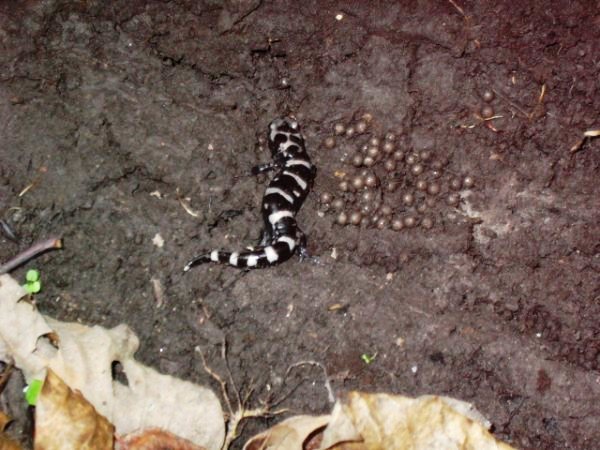Salamanders

On a recent field trip, our master naturalist class was treated to something really neat.
We flipped a log in a low swampy area and discovered a female marbled salamander (Ambystoma opacum) underneath. Upon closer inspection we realized that she was guarding a pile of silvery spheres (a small clutch of eggs). Female marbled salamanders lay 80 to 120 eggs under logs or in clumps of vegetation in wetland areas that are likely to flood. They will brood these eggs and even protect them from small predators like insects and other amphibians. When the fall and winter rains fill these nesting sites, the eggs hatch (within a few hours) and the larvae begin to grow and develop. After 3-8 months, the larvae metamorphose into solid dark gray salamanders and start their lives on land. They will develop the bold marbled patterns they are named for over the next few months. Males have a lighter-colored pattern than females. Adult marbled salamanders may live in the woods around the wetland and return to the same pond to breed and lay eggs.
Marbled salamanders are very handsome little beasts with striking patterns of light gray bands on a dark ground color. These chubby little guys are rarely more than five inches long from head to tail tip. They feed on small invertebrates including earthworms and a variety of insects. They have been known to live as long as ten years in the wild.
These salamanders are common residents of Carolina bays, river floodplains and other wetlands in the lowcountry. Like other amphibians, they require wetlands and a surrounding buffer of woods to carry out their lives. Some colleagues of mine have collected and released as many as twelve thousand salamanders from a single wetland about the size of a large residential yard in one day.
Many of our wetlands in the lowcountry have been destroyed or heavily altered to the point where amphibians cannot use them. Many of the wetlands that remain intact have been converted into fishing ponds making them unsuitable for most species. As you can imagine many types of fish feed on amphibians and their eggs. Proper study of the amphibian communities and the wetlands they live in will help us to understand the role that salamanders, frogs and toads play in the ecology of our area. Check out the picture taken by Jean Gilbert (a member of our current master naturalist class).
Tags: herps